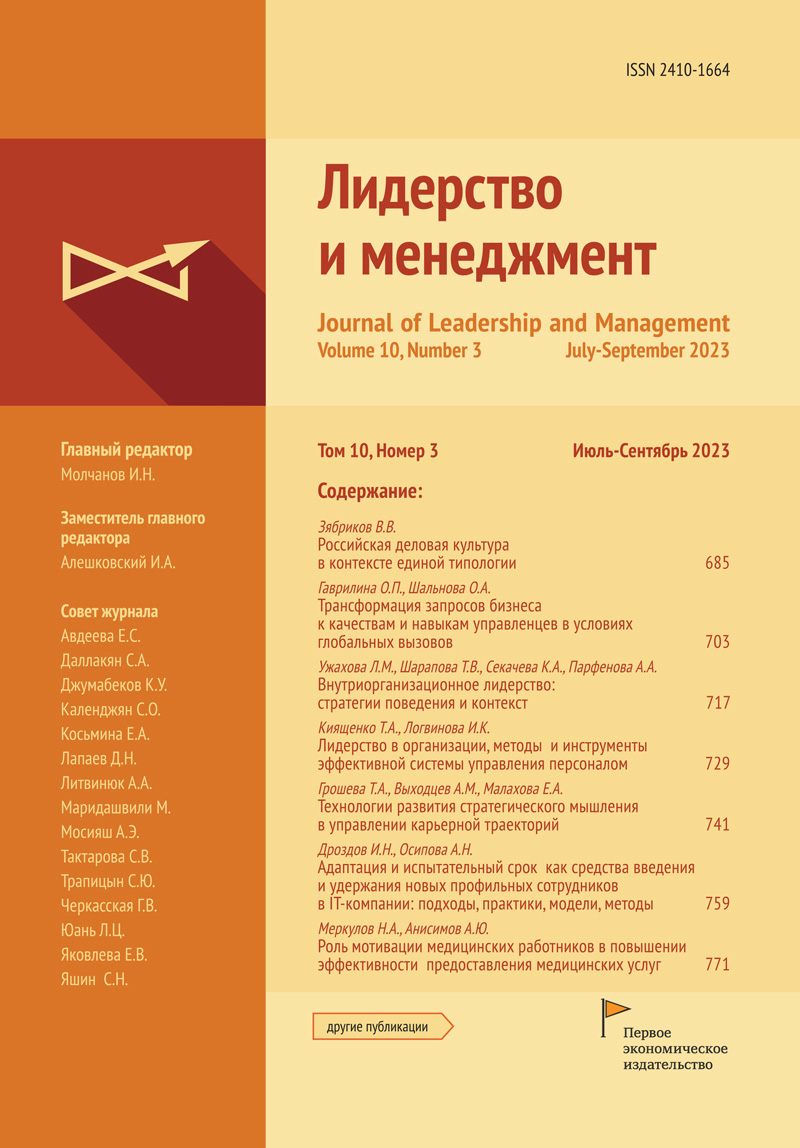Management of trade and production organizations in a turbulent economy
- Authors: Martynenko O.E.1, Razumova Y.V.1
-
Affiliations:
- Vladivostok State University
- Issue: Vol 10, No 3 (2023)
- Pages: 1033-1046
- Section: Articles
- URL: https://journals.eco-vector.com/2410-1664/article/view/608032
- DOI: https://doi.org/10.18334/lim.10.3.118651
- ID: 608032
Cite item
Abstract
The normative-legal framework of trade and production organizations is defined. In the context of the necessity of their adaptability to the conditions of the changing environment a review of approaches to management in the organizations of the named sphere has been conducted. In the course of the description of existing approaches the place of Agile project management in management of trade and production organizations in turbulent economy was determined. Regarding the process approach, the lack of flexibility in changing priorities among the variety of projects implemented in the organization was revealed. Along with the scientometric study, a visualization of the project management stages for trade and production organizations was carried out. It has indicated the points where the influence of external environment factors is recorded.The necessity of application of Agile project approach in management of trade and production organizations has been substantiated. Based on the study of authoritative sources revealed that the Agile approach is an iterative project management methodology. To find answers to the research question, the following research methods were used: text mining and method of article text interpretation, formal-logical tools, and content analysis. The personal experience of the author of the article in project management of trade and production organizations allowed to identify two loops and give a description of the stages in the structure of iterations, called sprints, and taking a cycle of 21 working days. The advantages of Agile management in comparison with the traditional project approach in trade and production organizations have been singled out. The author's conclusion is formulated that in the conditions of turbulence the dynamically changing environment of organization functioning often forces to make adjustments at any stage and in any part of the project realization. In such a case, the linear construction of the project is subject to the risk of irrelevant results in the conditions of the need for cardinal changes, which is a prerequisite for the deep study and formation of adaptive mechanisms for the implementation of flexible approaches in project management.
About the authors
Oleg Evgenevich Martynenko
Vladivostok State University
Email: moe_vld@mail.ru
Yuliya Viktorovna Razumova
Vladivostok State University
Email: yuliya_razumova@mail.ru
References
- Федеральный Закон «О государственной регистрации юридических лиц и индивидуальных предпринимателей» № 129-ФЗ от 08.08.2001. Consultant.ru. [Электронный ресурс]. URL: http://www.consultant.ru/document/cons_doc_LAW_34112/ (дата обращения: 01.03.2023).
- Григорьева Е.П., Шамова Т.Н. Особенности процессного подхода в управлении торгово-производственными организациями // Вестник МГСУ. – 2019. – № 8. – c. 1011-1020.
- Шумейко Н.А., Казаков А.Ю. Проектное управление: методология и практика. - Москва: Издательство «Юрайт», 2011. – 45-65 c.
- Turner J.R., Müller R. On the nature of the project as a temporary organization // International Journal of Project Management. – 2003. – № 1. – p. 1-8. – doi: 10.1016/S0263-7863(02)00020-0.
- Highsmith J. Agile Project Management: Creating Innovative Products. Pearson Education. - 2009
- Wysocki R.K. Effective project management: traditional, agile, extreme. - Hoboken, NJ: John Wiley Sons, 2013. – 768 p.
- A guide to the project management body of knowledge (PMBOK guide). / (6th ed.). - Newtown Square, PA: Project Management Institute,, 2017. – 579 p.
- Arshad R., Ahsan K., Hussain J. Project Management in Retail: Sectoral Issues and Future Research // Journal of Organizational Change Management. – 2019. – № 5. – p. 625-638.
- Hanisch B., Wald A. Project management for small and medium-sized enterprises // Procedia-Social and Behavioral Sciences. – 2011. – p. 622-631.
- Мамедова Г.А. Управление проектами в торговых компаниях // Наука и техника. – 2015. – № 3. – c. 52-54.
- Комиссарова Н.В., Павлова Е.А. Традиционное и гибкое управление проектами в торговой организации // Вестник Санкт-Петербургского университета экономики. – 2017. – № 3. – c. 292-305.
- Петрова М.В., Богданова Н.И. Управление проектами в сфере торговли и услуг // Вестник Удмуртского университета. Серия Экономика и право. – 2019. – № 2. – c. 141-146.
- Соколова И.С., Мирошник Е.А. Управление проектами в торговых компаниях // Экономика и управление. – 2019. – № 1. – c. 36-42.
- Beck K., Fowler M., Highsmith J. Manifesto for Agile Software Development. Agilemanifesto.org. [Электронный ресурс]. URL: https://agilemanifesto.org/ (дата обращения: 22.03.2023).
- Thakur D., Haleem A. Agile project management in the retail industry: A case study // Journal of Retailing and Consumer Services. – 2019. – p. 443-451.
- Zeng S.X., Tam C.M., Tam V.W.Y. Agile project management in manufacturing environments: Overcoming project uncertainties through transparency and dynamic adaptivity // International Journal of Production Economics. – 2008. – № 2. – p. 387-404.
- Villena-Román J., Gutiérrez-Taño D., Pozo-Rico T. Agile retail: a novel approach for organizational agility // Journal of Business Research. – 2020. – p. 586-594.
- Liu J., Antony J., Joseph C. Agile manufacturing: the drivers, concepts and research directions // International Journal of Production Research. – 2013. – № 23-24. – p. 6917-6935.
Supplementary files









